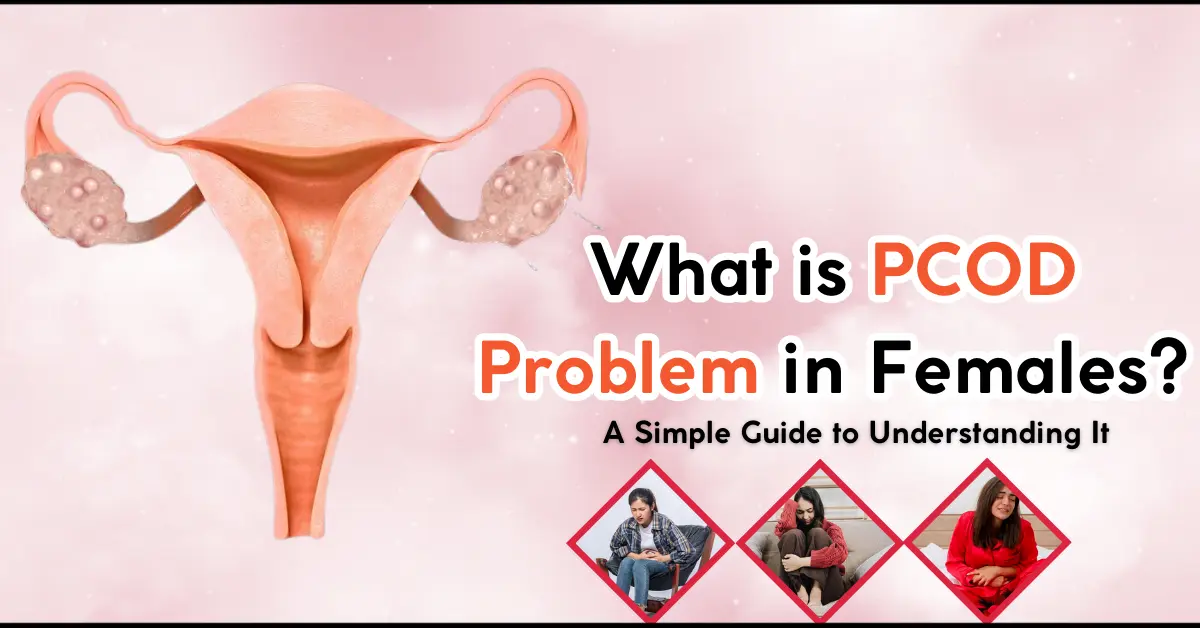
What is PCOD Problem in Females?- A Simple Guide
- 244
- 0
- 0
What is PCOD Problem in Females?

Polycystic Ovary Syndrome (PCOS), often referred to as PCOD (Polycystic Ovary Disease), is a common health problem affecting many women of reproductive age. Despite its prevalence, PCOS is often misunderstood, which can lead to stress and confusion. This guide aims to explain PCOS in simple terms, including its causes, symptoms, diagnosis, and ways to manage it effectively.
Introduction
Let’s know about the thing – what is PCOD problem in females – PCOD, or Polycystic Ovary Disease, is a common hormonal disorder that affects many women during their reproductive years. It is characterized by the formation of multiple small cysts on the ovaries, which can lead to various symptoms and potential health concerns. One of the primary causes of PCOD is an imbalance in the levels of hormones produced by the body, particularly insulin and androgens (male hormones). This hormonal imbalance can disrupt the normal functioning of the ovaries, leading to the development of cysts.
After knowing about what is PCOD problem in females, Women with PCOD may experience a range of symptoms, including irregular or absent menstrual periods, excessive hair growth (hirsutism), acne, weight gain, fertility issues, and an increased risk of developing other health conditions like diabetes, high blood pressure, and heart disease.
Causes of PCOD

The exact cause of PCOD remains unclear also after knowing what is PCOD problem in females, but it is believed to result from a combination of genetic, environmental, and lifestyle factors. Key contributing factors include:
- Insulin Resistance: Many women with PCOD have insulin resistance, meaning their bodies do not respond effectively to insulin. This leads to higher levels of insulin, which can increase androgen production and disrupt normal ovulation.
- Hormonal Imbalance: Elevated levels of androgens (male hormones) are commonly found in women with PCOD. This hormonal imbalance can interfere with the development and release of eggs during ovulation.
- Inflammation: Chronic low-grade inflammation is often observed in women with PCOD. This inflammation can stimulate the ovaries to produce androgens.
- Genetics: PCOD tends to run in families, suggesting a genetic component. Women with a mother or sister with PCOD are at a higher risk of developing the condition.
Symptoms of PCOD

The symptoms of PCOD can vary widely among individuals, but common signs and symptoms include:
Irregular or Absent Periods:
In PCOD, the hormonal imbalance can interfere with the regular ovulation process, leading to irregular or missed periods. Some women may experience infrequent periods, while others may not have a period for several months at a time.
Excessive Hair Growth (Hirsutism):
The increased levels of androgens (male hormones) in PCOD can cause excessive hair growth on the face, chest, back, and other areas of the body where women typically do not have much hair.
Acne:
The hormonal imbalance in PCOD can also lead to the overproduction of oil in the skin, which can clog pores and result in acne breakouts.
Weight Gain:
Women with PCOD often struggle with weight gain, particularly around the abdomen. This can be due to insulin resistance, which can lead to increased appetite and difficulty losing weight.
Fertility Issues:
PCOD is one of the leading and primary causes of the infertility in women. The hormonal imbalance can prevent ovulation, making it difficult to conceive naturally. However, with the proper treatment and care , many women with the PCOD problems can achieve the pregnancy.
Other Health Concerns:
PCOD is associated with an increased risk of developing other health conditions, such as type 2 diabetes, high blood pressure, and heart disease. This is because the hormonal imbalance and insulin resistance can contribute to these conditions.
Diagnosis and Treatment
Diagnosis of PCOD
Diagnosing PCOD typically involves a combination of clinical evaluation, medical history, and specific tests. There is no single test for PCOD, but the following criteria (known as the Rotterdam criteria) are commonly used for diagnosis:
- Irregular Menstrual Cycles: Evidence of oligo-ovulation or anovulation (infrequent or absent ovulation).
- Hyperandrogenism: Clinical signs (such as hirsutism or acne) or biochemical evidence (elevated levels of androgens).
- Polycystic Ovaries: Detection of 12 or more follicles in each ovary or increased ovarian volume via ultrasound.
A diagnosis of PCOD is confirmed if a woman meets at least two of these three criteria and other conditions with similar symptoms are ruled out.
Complications of PCOD
PCOD is associated with several long-term health risks, including:
- Type 2 Diabetes: Due to insulin resistance, women with PCOD are at a higher risk of developing type 2 diabetes.
- Cardiovascular Disease: Increased risk factors for heart disease, such as high blood pressure, high cholesterol, and obesity, are common in women with PCOD.
- Endometrial Cancer: Prolonged absence of menstruation can lead to a buildup of the endometrial lining, increasing the risk of endometrial cancer.
- Sleep Apnea: Obesity and insulin resistance associated with PCOD can increase the risk of obstructive sleep apnea.
- Mood Disorders: Higher prevalence of depression, anxiety, and eating disorders.
Management and Treatment of PCOD
While there is no cure for PCOD, various treatment options can help manage symptoms and reduce the risk of complications. The management of PCOD typically involves a combination of lifestyle modifications, medications, and other interventions:
Lifestyle Modifications
- Diet and Nutrition: A balanced diet rich in whole foods, lean proteins, and healthy fats can help manage weight and improve insulin sensitivity. Reducing refined carbohydrates and sugars is particularly beneficial.
- Exercise: Regular physical activity helps improve insulin resistance, aid in weight management, and enhance overall health. Strive to engage in at least 150 minutes of exercise per week at a moderate intensity.
- Weight Management: Losing even a small percentage of body weight (5-10%) can significantly improve PCOD symptoms and reduce health risks.
Medications
- Hormonal Birth Control: Oral contraceptives can regulate menstrual cycles, reduce androgen levels, and help manage symptoms such as acne and hirsutism.
- Anti-Androgens: Medications like spironolactone can block the effects of androgens and reduce excessive hair growth and acne.
- Metformin: This medication, commonly used for type 2 diabetes, can improve insulin resistance and help regulate menstrual cycles.
- Fertility Treatments: For women trying to conceive, medications like clomiphene citrate or letrozole can stimulate ovulation. In some cases, assisted reproductive technologies (ART) such as in vitro fertilization (IVF) may be necessary.
Alternative Therapies
- Supplements: Some women find relief with supplements like inositol, which may improve insulin sensitivity and hormonal balance. It’s important to seek advice from a healthcare professional before beginning any dietary supplements.
- Acupuncture: Some studies suggest acupuncture may help regulate menstrual cycles and reduce PCOD symptoms, though more research is needed.
Emotional and Psychological Support
Living with PCOD can be challenging, and the emotional impact should not be underestimated. Women with PCOD may experience feelings of frustration, sadness, and anxiety. Seeking support from mental health professionals, support groups, or counseling can be beneficial in managing the psychological aspects of the condition.
Women with PCOD need to work closely with their healthcare providers to manage the condition and address any potential complications. Early diagnosis and proper management can help alleviate symptoms, reduce the risk of associated health issues, and improve overall quality of life. Remember, PCOD is a common condition, and with the right support and treatment, women can effectively manage their symptoms and maintain a healthy lifestyle.
FAQs
Q1: What is PCOD?
A: PCOD is a hormonal disorder common in women of reproductive age. It causes irregular periods, excess male hormones, and small cysts on the ovaries. This can lead to various health issues and fertility problems if left untreated.
Q2: What are the main symptoms of PCOD?
A: Common PCOD symptoms include irregular or missed periods, heavy bleeding, excess facial and body hair, acne, weight gain, and difficulty getting pregnant. Some women may also experience hair loss, mood changes, and dark skin patches.
Q3: How is PCOD diagnosed?
A: Doctors diagnose PCOD through a combination of methods: discussing symptoms, physical examination, blood tests to check hormone levels, and pelvic ultrasound to look for ovarian cysts. Two out of three criteria confirm the diagnosis.
Q4: Can PCOD be cured?
A: There’s no permanent cure for PCOD, but its symptoms can be managed effectively. Treatment options include lifestyle changes, medications to regulate periods and reduce symptoms, and fertility treatments if pregnancy is desired.
Q5: How does PCOD affect fertility?
A: PCOD can make it harder to get pregnant because it often causes irregular ovulation or prevents ovulation altogether. However, many women with PCOD can still conceive with proper treatment and lifestyle changes.
Also Read:
What is PCOD Problem in Females: A Common Condition
Understanding The Top 7 PCOD Problem Symptoms
What is the PCOD problem? All you need to know in 2024.
References:
https://www.ncbi.nlm.nih.gov/books/NBK459251/
https://www.ncbi.nlm.nih.gov/pmc/articles/PMC6489978/
https://www.ncbi.nlm.nih.gov/pmc/articles/PMC4341818/
https://en.wikipedia.org/wiki/Polycystic_ovary_syndrome
Disclaimer:
The information provided in this guide about PCOD (Polycystic Ovarian Disease) in females is for general informational purposes only. It is not a substitute for professional medical advice. Consult a healthcare provider for personalized diagnosis and treatment options.
Related post

7 Health Benefits of Assam Tea


